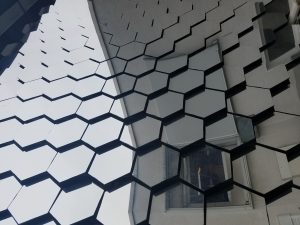This morning I commuted from Cologne to Bonn all by myself: an insignificant task for many, but a monumental accomplishment for a car-driving Tennessean such as myself. I was out the door this morning before most of my classmates because I was attending an energy research excursion sponsored by the EnergyAgencyNRW (Northwest Rhine Westphalia), a state-sponsored energy consultancy.
Along with a diverse assortment of fellow energy enthusiasts, I travelled to the German Aerospace Center, DLR to hear from energy and materials scientists about their exciting research into a number of innovative new energy technologies. We first toured their molten salt thermal storage unit, a mechanism of storing energy as thermal heat in well insulated chambers. The salts flow back and forth between a “cold” chamber (roughly 370 degrees Celcius) and a hot chamber (800+ degrees Celcius), heated by excess solar-powered electricity and cooled later when energy demand ramps and the sun is no longer shining. It is cooled by transferring its thermal energy to water, which vaporizes and turns a turbine to generate electricity. This technology is among several storage solutions which will be imperative to achieving the 100% renewable energy system that Germany is striving towards.

Next we visited the DLR solar furnace, an ingenious array of mirrors which concentrates solar radiation to achieve incredibly high temperatures. Hundreds of spherical mirrors redirect sunlight to a golf ball sized focal point, producing temperatures of 2500 degrees Celcius. For reference, this array can melt solid steel in under 30 seconds using only the sun’s natural energy. This technology has innumerable applications in driving industrial processes, producing renewable chemical fuels, and generating electricity.

From the DLR facility, we travelled to the University of Bonn Klein-Altendorf plant science department to learn about their research into sustainable biofuels and agroecology. Scientists at the university grow a variety of cellulosic plants to use in consumer goods, building materials, and combustion-driven electricity generation. These materials do release carbon when burned, but it is the same amount of carbon that they previously sequestered during growth, thereby achieving nearly carbon-neutral electricity.
We concluded our excursion at the Deutsches Museum Bonn to tour their hydrogen fuel exhibit. We learned about how hydrogen fuel is generated from water before being condensed and used as fuel in cars and buses. I discussed the technology at length with an employee of EnergyAgencyNRW’s hydrogen fuel cell subsidiary, trying to grasp the substantive differences between hydrogen powered transportation and battery powered transportation. I am personally not convinced of the advantages of hydrogen fuel over battery power due to the considerable energy losses in the hydrogen processes. However I acknowledge that if we are to achieve a fully renewable energy system, we must research every opportunity that may advance us towards that vitally important goal. And it was really cool to ride on a hydrogen powered bus!!
More climate change solutions tomorrow.
-John Higham